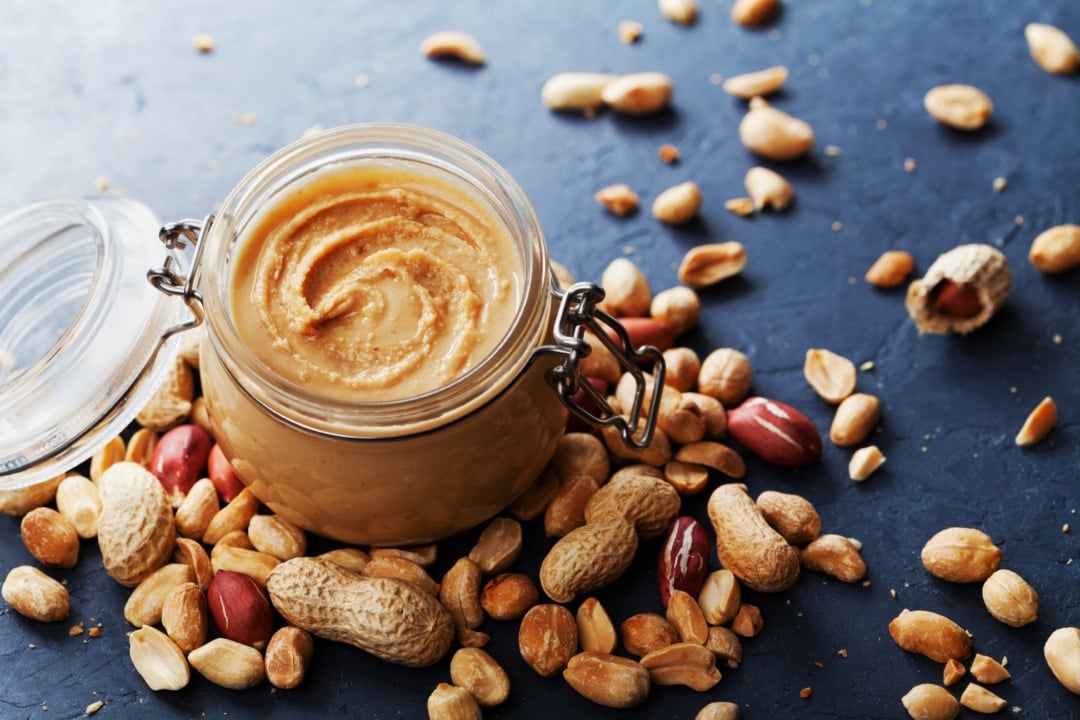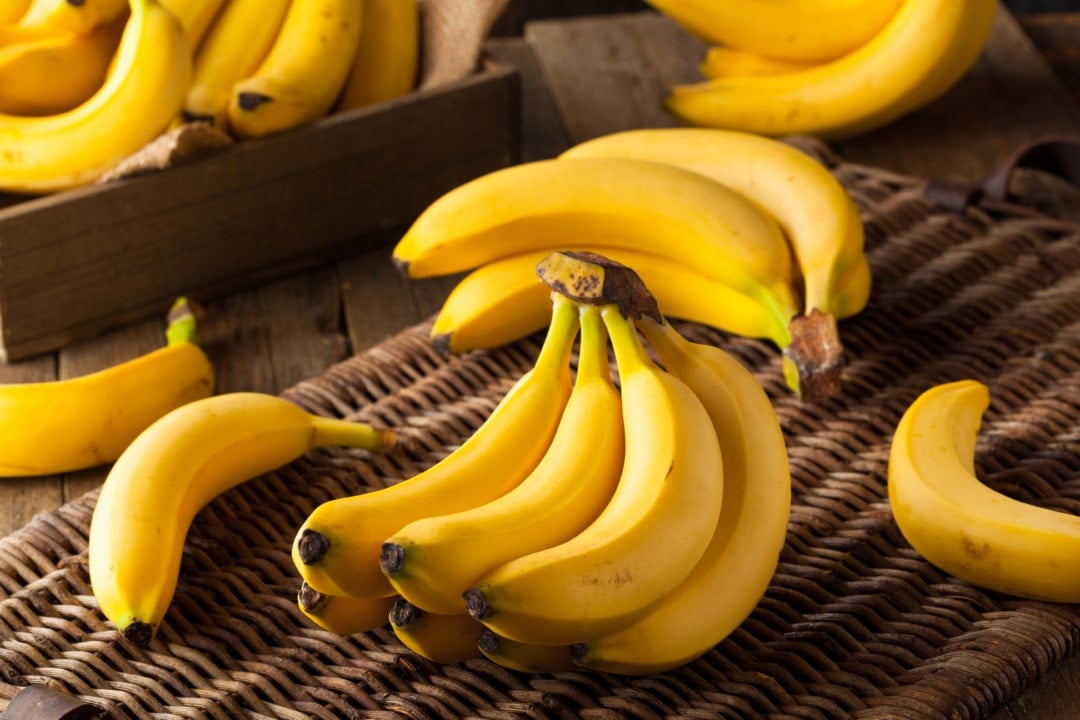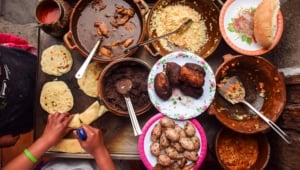Mediterranean Food: 25 Popular Dishes in 4 Categories
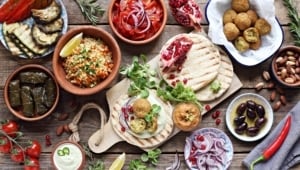
With Italian, Turkish, Greek, Spanish, Levantine, and North African influences, it’s no wonder that Mediterranean cuisine is taking the international food scene by storm. But how do these Mediterranean food cultures work together? That’s what we’ll discover here.
Mediterranean food is often healthy, accessible, and delectable all at once. If you want to give it a go, you’re in the right place. This post will walk you through 25 phenomenal recipes.
We’ll also check out some handy tips to make the shift to Mediterranean-style cooking as smooth as possible.
Traditional Mediterranean Cuisine – More Than Dolma and Doner

Traditional Mediterranean Cuisine – More Than Dolma and Doner
Traditional Mediterranean cuisine is a product of cultural exchanges between a number of countries in Asia, Europe, and Africa.
Thanks to this exchange, we have the culinary traditions that set the foundation for the so-called healthy “Mediterranean diet” we know today. But the cooking style is more nuanced than the simple meal plans that the diet is known for.
Most Popular Street Food in the Mediterranean

Most Popular Street Food in the Mediterranean
Each country (and sometimes each city) has a signature contribution to the cuisine’s street food scene. Yet, they’re all affordable and delicious. Here are the most popular treats and snacks that you can grab from Mediterranean-style stalls:
- Gyro: Your choice of rotisserie-cooked meat sliced and wrapped in soft, warm pita bread.
- Falafel: Irresistible fava bean or chickpea-based fritters that are good to go in wraps, with ful medames, or next to a side of baba ganoush.
- Maakouda: Some say it’s a tiny savory cake. Others say it’s a fritter. Either way, this fried potato treat from Morocco’s streets is finger-licking good.
- Arancini: If you’re in Sicily, you have to try these gooey, crunchy, and steaming hot fried rice balls.
- Patatas Brava: This crispy hit from Spain’s food stalls is served with a spicy sauce and a garlic aioli.
- Loukoumades/Lokma/Luqmat el-Qadi: Whether you’re in Turkey, Greece, Egypt, or Cyprus, you’ll find street vendors selling these bite-sized fluffy donuts. You can get them topped with syrup, powdered sugar, chocolate, or chopped walnuts.
Mediterranean Food in the World

Mediterranean Food in the World
If you walk down the dip and sauce aisle in your local supermarket, odds are, you’ll find hummus and harissa. Turn over to the herb section, and you’ll spot some za’atar.
Even street food, like doner/gyros and falafel, is making its way into cities all over the world, from New York to Hong Kong.
These delicacies are what we call “gateways” to Mediterranean cuisine. It makes sense that street food and pre-packaged items are getting popular. After all, they’re convenient, delicious, and ideal for immigrants and people who are open to trying new cuisines.
But the interesting thing is that homemade Mediterranean food is also having a moment. Why? Well, the Mediterranean diet is touted as a health-conscious eater’s dream. It’s flexible, delicious, and not as restrictive as the word “diet” might imply.
Years ago, researchers noticed that the people around the Mediterranean were generally heather than the average Westerner. That was clear in the heart disease rates, too. Soon, they realized that the diet there was worth investigating.
The results came in to confirm the researcher’s theories. From there, the term “Mediterranean diet” was coined to describe the dietary habits of traditional Mediterranean populations (especially Greece and Southern Italy).
This helped introduce the world to the cuisine of even more regions in the basin, from Spain to Syria.
Nowadays, the diet is considered an intangible cultural heritage by UNESCO. That’s not surprising when you consider that the cuisine is about more than just food. It represents important values like hospitality, neighborliness, and diversity.
How Healthy Mediterranean Food Is

How Healthy Mediterranean Food Is
So, the cuisine is considered healthy, but why is that? While there’s no solid definition or guidelines for the Mediterranean diet, a few dietary habits make it generally good for our health. Here are the hallmark characteristics:
- Plant-Based: The focus of most recipes isn’t on animal products and meat. Instead, the diet includes a diverse selection of vegetables, legumes, fruits, nuts, and whole grains.
- Healthy Fats: Mediterranean recipes usually lean heavily into cold-pressed extra virgin olive oil (known for its healthy monounsaturated fats) rather than butter.
- Seasoning Diversity: When you use a large selection of herbs and spices, it’s easier to cut back on the salt and spare your blood pressure.
- Minimally Processed: Highly processed foods and sugary beverages are mostly avoided in the traditional diet.
All these characteristics can explain why some people believe Mediterranean food is healthier, but it’s not just theoretical talk—there’s evidence to back it all up.
For one, research found that this regional diet can help with weight loss. Plus, it’s tied to reduced risk of cardiovascular diseases and type 2 diabetes.
Unfortunately, there are a few caveats. The common one is that olive oil and nuts are all heart-healthy but also full of calories. So, you’ll want to watch your portions and eat them in moderation.
Famous and Popular Mediterranean Dishes You Have to Try

Famous and Popular Mediterranean Dishes You Have to Try
The Mediterranean cuisine is incredibly diverse because the basin itself is also pretty diverse. The included countries change depending on who you ask. But we’re talking about 20+ countries bordering the Mediterranean Sea.
To list all the popular Mediterranean dishes worth trying, we’d need days and a much, much longer article. But we can go over the highlights just to give you an idea of what to expect. So, without further ado, let’s check out the top picks by category.
Soups and Salads

Soups and Salads
Because vegetables, legumes, and grains are star ingredients, it’s only natural to have a large selection of salads and soups next to your mains. No, it’s not just Greek salad, tabbouleh, and white bean soups. There’s a lot more to explore.
Lentil Soup

Lentil Soup
The Mediterranean might be known for its pleasant climate and mild winters. But even those mild winters call for a heartwarming, nourishing soup. As it happens, a bowl of bold lentil soup is a prime candidate, especially when you serve it next to a basket of warm flatbread.
There are a few renditions, and all are chock-full of aromatics and species. Some recipes use green or yellow lentils, while others rely on the sweet red variety.
For first-timers, we recommend red lentil recipes as they tend to cook a bit faster. You can even whip up the soup in an instant pot if you’re in a rush.
Harira

Harira
If you want to take your lentil soup to the next level, consider making a Moroccan harira instead. Harira delivers a combo of lentils and chickpeas floating in a broth of fresh herbs, tomato paste, cilantro, and warm spices.
To understand how divine the texture is, you just need to look at the name. Many believe the name is derived from the Arabic word “harir,” which actually means silk. We’d say this is a rather abt description of this velvety soup.
Cucumber and Tomato Salad

Cucumber and Tomato Salad
One of the most popular salads in the region is the all-star cucumber tomato salad. The name gives away the two main ingredients, but the recipe could also use onions, parsley, and peppers. If you want extra tang, toss some feta cheese into the mix.
The key to nailing this recipe is dicing your veggies into small cubes. Forget the chunky pieces of traditional Western salads. Of course, this salad won’t be authentic without a good drizzle of olive oil, a hint of white vinegar, and a squeeze of lemon.
Creamy Cucumber Salad
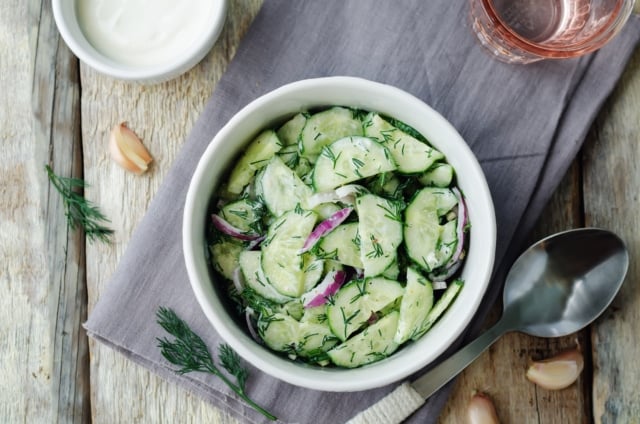
Creamy Cucumber Salad
Maybe you’re serving a particularly spicy dish with a side of red-hot harissa. In this case, you’ll need all the refreshing and cooling power you can get. The traditional cucumber tomato salad might not cut it, but the creamy blend of cucumber and yogurt will undoubtedly do the trick.
Thankfully, the creamy cucumber salad is easy to make. All you need is cucumbers and a yogurt dressing. What’s in the dressing, you ask?
Well, a dose of plain yogurt mixed with lemon zest, garlic powder, dill, black pepper, olive oil, and a touch of salt. Some mint will do wonders as well. Yes, this is pretty much the tzatziki dip in salad form.
Bulgur Bowl

Bulgur Bowl
If you’re craving a protein kick from your salads and don’t mind dealing with some cooking time, the good-old bulgur bowl is the Mediterranean recipe for you. For protein, you have chickpeas.
However, the salad also features scallions, parsley, baby spinach, tomatoes, onions, lemon juice, and, obviously, some nutty bulgur grains.
Mozzarella (or feta cheese) can give the bowl extra dimension. Some people also like adding pomegranate molasses. Feel free to play around with the recipe until you find a mix that works best for you.
Starters, Sandwiches, and Sides

Starters, Sandwiches, and Sides
Salads are essential for the cuisine, but there’s more to consider. So, let’s put the salads aside and edge closer to the hearty, filling stuff. Whether you’re looking for a mouthwatering appetizer, a healthy side dish, or a sandwich to eat on the go, you’ll find something for you here:
Stuffed Grape Leaves

Stuffed Grape Leaves
Call it dolma, dolmades, or japrak—the different names don’t change the fact that stuffed grape leaves are a Mediterranean staple. In many regions, stuffed leaves are served as appetizers. However, it’s not uncommon to see the recipe treated as a main dish in some Middle Eastern households.
You’ll likely also notice some variation in the technique and stuffing, based on where you are in the Mediterranean. Some folks stuff the leaves with ground beef. Meanwhile, others strictly use an aromatic blend of rice, parsley, dill, and tomatoes.
Shawarma
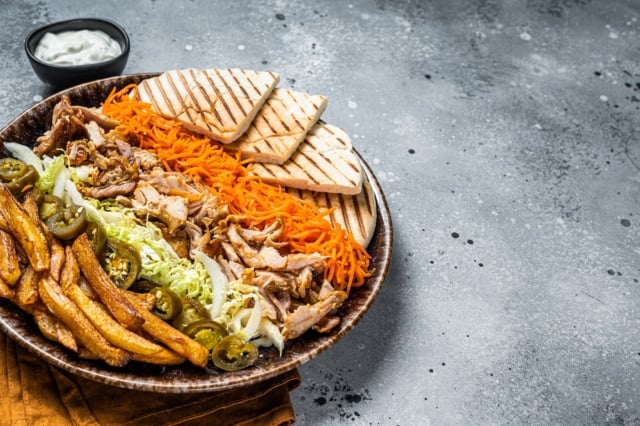
Shawarma
With so many renditions available today, it’s hard to pinpoint where shawarma originated. What we can say is that the classic Levantine recipe is a must-try, and you’ll likely find it in many Mediterranean cities. Chicken, veal, lamb, or goat meat are all possible options.
Regardless of the meat type, you’ll need to pair your shawarma with a plate of pickles to get the full experience. Carrots, turnips, olives, and cucumbers are your best bet here. Just don’t forget to grab a side of fries and creamy garlic tomia.
Panini

Panini
Yet another iconic Mediterranean sandwich to try is the grilled panini, with its rich flavors and well-balanced textures. Most panini variations aren’t super hearty. The sandwich is good enough for brunch, though.
A typical panini features split ciabatta rolls, but sourdough and baguettes will both do in a pinch. For the stuffing, you could use chicken breasts with dried tomatoes and roasted peppers or go for a cold turkey sandwich with crumbled feta cheese.
Anyway, you’ll need to grill the panini until the bread is all nice and golden.
Mediterranean Cauliflower

Mediterranean Cauliflower
We know cauliflower gets a bad rap, but you have to take our word on this: this dish is not even remotely bland. The cumin and fresh lemon combo gives the cauliflower a zesty flavor profile. Then, the oven-roasting adds a brilliant hint of nuttiness that takes the dish to the next level.
If you want your side dish to double as a showstopper, consider roasting and serving the cauliflower whole. Then, top it with some pomegranate molasses and seeds for color.
Just like that, you’ve got an aesthetically pleasing variation without compromising the authentic Mediterranean recipe.
Roasted Eggplant With Tomatoes

Roasted Eggplant With Tomatoes
Eggplant is already a popular veggie in Mediterranean cuisine, but imagine pairing it with ripe tomatoes, garlic cloves, fresh basil, and a good chunk of olive oil. Doesn’t that sound hearty and aromatic?
It’s such a filling side dish that all it needs is some pasta and maybe a handful of pine nuts to make a complete meal.
Of course, it’s also possible to spread the roasted veggies over crusty bread if you’re in the mood for a snack.
Now, to be fair, the recipe takes around an hour of total cooking time, but it’s not that hard to master. Plus, it’s well worth the effort, given how it highlights the savory Mediterranean flavors.
Caponata

Mediterranean
The Sicilian caponata is yet another Mediterranean diet recipe where eggplant shines. Think of Caponata as a vegan eggplant appetizer. The key ingredients are roasted eggplant cubes and a mixture of tomatoes, capers, celery, onions, and bell peppers that have been cooked in a skillet.
A small serving of lightly oiled and toasted ciabatta bread balances the texture of the soft veggies perfectly. The catch is that caponata as a starter is best served at room temperature. So, you might want to start preparing it an hour or so before dinner.
Couscous

Couscous
Many Mediterranean recipes feature rice or pasta, and both are perfectly fine. However, it’s hard to rely on a diverse Mediterranean diet and not run into couscous every now and then. That’s particularly true if you’re focusing on the recipes from North Africa.
Couscous is so versatile and ingrained in the cuisine that it works as a side to protein dishes, a salad ingredient, and even a dessert component.
After all, it doesn’t have an overwhelming taste on its own. It’s somewhat nutty but blends in perfectly with other flavors, making it a perfect base for experimenting with Mediterranean main dishes.
Mains

Mains
Plenty of Mediterranean recipes are plant-based, from fasolakia lathera to grilled eggplant. Even the recipes with animal protein have a decent share of veggies. Here are some recipes to take the spotlight on your dinner (or breakfast) table:
Shakshuka

Shakshuka
Shakshuka can easily be the star of the show at any brunch or breakfast in the North African region of the Mediterranean. It’s healthy, flavorsome, egg-based (to really fill you up), and easy to make. In fact, the dish is nothing more than a few eggs and a chunky, spicy sauce.
What you choose to put in your chunky sauce is up to you. That said, many authentic recipes use onions, coriander, fresh tomatoes, green bell peppers, parsley, and paprika. All these goodies are cooked in a bit of oil in a skillet. Then, you pour your eggs into “wells” in the sauce.
Chicken Tagine

Chicken Tagine
Tagines are a sort of simmered stew with a rich blend of Moroccan flavors. Think harissa, coriander, garlic, lemon (skin and all), olives, parsley, and cilantro. This mix should deliver a kick to your chicken.
Traditionally, tagine recipes would be cooked in a special earthenware dish to slow-cook the meat until it’s all tender. However, you can use a crockpot or a ceramic pot in a Dutch oven. But what you should never compromise on are the spices and presentation.
Baked Kibbeh in a Pan

Baked Kibbeh in a Pan
Kibbeh, a bulgur and minced meat croquette, is popular in the Eastern region of the Mediterranean. Now, you might have seen it served as a starter somewhere. The truth is kibbeh could work as an appetizer for a house party or as a main course, depending on how you prepare and serve it.
To frame it as a main dish, consider making the kibbeh bil sanieh (kibbeh in a pan) version. It can be more filling than the traditional kibbeh balls, and it’s even less of a hassle to prepare.
Either way, tahini, tzatziki, and the classic Mediterranean chickpea salad are all suitable pairings.
Shish Kebabs

Shish Kebabs
From the Caucasus shashlik to the French brochette, you’ll find dishes similar to shish kebab in different cuisines around the world. But since we’re talking about the Mediterranean here, kebab (sometimes called kebob) is the summer BBQ main dish we need.
Traditionally, kebabs are made with lamb. The trick is to get a tender cut and marinate it in olive oil, freshly squeezed lemon juice, grated ginger, black pepper, and sea salt overnight for best results. If you don’t have this sort of time, set at least a couple of hours for marinating.
Saucy Chicken

Saucy Chicken
For those looking for the ultimate Mediterranean weeknight dinner, the one-skillet chicken would be a strong contender. The recipe is easy to tweak. But the goal is to cook chicken pieces with olives in a sauce of stock, tomato paste, lemon juice, and olive oil.
You definitely could serve the chicken as-is next to a salad and call it a day. However, a side of long-grain rice would balance the flavors and help turn the dish into a more balanced meal.
If you’re feeling particularly lazy, skip the tomato paste and cook the rice with the seared chicken in the same skillet/pan.
Risotto
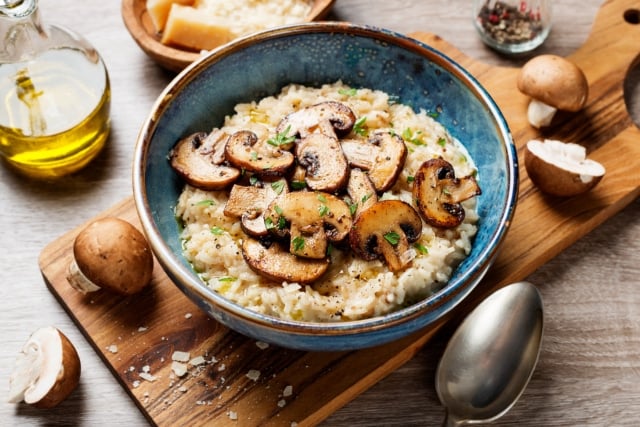
Risotto
One-pot vegetable risotto is a hassle-free, highly customizable recipe. Technically, any rice will do, but Arborio and Carnaroli are popular picks.
Still, to really turn this dish into a filling main, add sliced mushrooms to give the dish extra umami flavor. Then, top it all up with parmesan cheese and fresh basil.
Moussaka
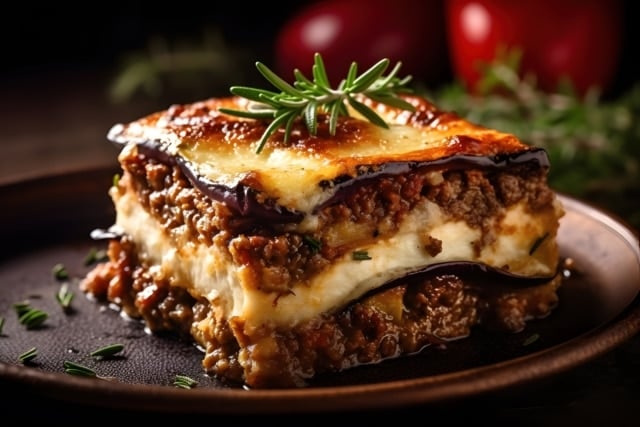
Moussaka
There are a few bechamel-based dishes in the cuisine, but moussaka proves that you don’t always need pasta for those rich mains. Just picture lasagna but with thinly sliced potatoes and eggplant rather than pasta. That’s basically what moussaka is, and it’s every bit as comforting as lasagna.
Many moussaka recipes include lamb. But you can leave the meat out and turn the casserole vegetarian. Regardless, a cucumber salad and a side of lemon-roasted potatoes will pair well with the main dish. Some crusty bread will balance the texture, too.
Baked Cod

Baked Cod
We can’t talk about popular mains in Mediterranean cities and not have at least one fish-based dish on the list. Baked cod happens to stand out from the crowd.
It’s easy to prepare, smells incredible, and carries so much flavor. Bonus point: you can make this dish aesthetically pleasing by using cherry tomatoes, olives, and basil leaves to add color pops.
Usually, the cod is dotted with butter before it’s baked. So, the dish comes out saucy, and the fish doesn’t dry out. To bring out the best of this buttery sauce, we recommend incorporating a generous amount of garlic, olive oil, and some fresh lemon juice.
Bread, Pastries, and Dessert

Bread, Pastries, and Dessert
Just because Mediterranean food is healthy doesn’t mean it won’t satisfy your sweet tooth and carb cravings. After all, this is the cuisine that gave us fruit crostatas, baklava, apple empanadas, churros, and the legendary knafeh. Let’s check out some desserts and baked goodies.
Pita Bread

Pita Bread
You might see pita called Arabic or baladi bread in some regions. Regardless of the name, pita is a double-layered, pocketed flatbread made with flour, yeast, water, and salt.
Usually, it’s baked in the oven until it gets all fluffed up, but it’s also possible to make do with a cast-iron skillet on the stovetop.
Once you get your hand on the fluffy, steamy, hot pita bread, you can use it with pretty much any Mediterranean sauce or dip. We’re talking hummus, tzatziki, tahini, and baba ganoush. Of course, the bread makes perfectly soft falafel sandwiches as well.
Olive Bread

Olive Bread
One way to put the Mediterranean briny olives to good use is to make a loaf of bread. Olive bread is all crusty on top but super chewy on the inside. Bite into it, and you’ll find bits of black and green olives embedded deep into the loaf.
At first glance, it’ll look like it’s adorned with raisins or chocolate chips. Still, this bread is as savory as it gets. So, by all means, feel free to serve buttered slices of olive bread with a charcuterie board and wow your guests. A Greek salad on the side won’t hurt, either.
Borek

Borek
If you look at the savory pastries in Mediterranean cuisine, you’ll find a few phyllo-based dishes. Borek and Egyptian goulash happen to be high on the list and two of our favorites. But if tangy white cheese sounds better than beef, borek is the way to go.
Some people roll their borek into cigarette-shaped sticks with the stuffing in the middle. Others do one huge spiral in a baking pan. But if this is your first run with phyllo, it might be easier to bake a regular tray with layers of stuffing and dough.
No matter which shape you choose, don’t forget to top your pastry with sesame and nigella seeds. They’ll add extra pizzazz. All in all, the borek tray is mostly a forgiving recipe, so you can give it a go even if you’re a beginner.
Olive Oil Cake

Olive Oil Cake
The iconic olive tree of the Mediterranean has made its way to desserts, bringing along the same aroma and health benefits of the savory dishes. Using this recipe, you’ll swap the saturated fat in butter with the antioxidant-rich extra virgin olive oil in your cake batter.
The top flavor picks here are lemon and orange (with or without cardamom). Both can be great for special occasions since this cake isn’t really an everyday treat.
That’s not to say the cake is overly sugary or dense, though. Olive cake can be super fluffy if made with cake flour instead of all-purpose flour.
Baklava

Baklava
Some people believe baklava is originally from Greece. Others say it’s Turkish to the core. No matter where this debate goes, baklava is still one of the best desserts the Mediterranean cuisine has to offer.
The best part is that baklava leftovers are hardly ever a burden. These flaky treats taste even better the next day. All you need is a cup of hot black tea to let the phyllo dough and nuts shine again.
Secret Recipe Tips

Secret Recipe Tips
Since Mediterranean food culture and the diet inspired by it are both having their moment, you’ll likely find a specialized restaurant or stall near you.
Still, homemade food gets the upper hand for the rewarding feeling, if nothing else. To help you prepare Mediterranean recipes from scratch, we’ve rounded up some helpful tips and tricks.
Buy Only the Best Olive Oil (And Don’t Smoke It)

Buy Only the Best Olive Oil (And Don’t Smoke It)
A common misconception is that the “greener” the oil is, the better it’ll taste. That would be an extremely convenient way of judging quality if it were true. Unfortunately, it isn’t. So, don’t worry about the colors too much.
Instead, focus on getting extra virgin oil. It’s the least processed type. Still, even this oil will spoil at some point. That’s why it’s often better to get a tinted bottle to keep the light away.
It’s also a smart idea to buy several varieties and do a quick taste test to see which suits your cooking style. This can cost a pretty penny. But the good news here is that you don’t have to cook full meals to test the oils, either.
Just pour a tiny bit into a glass, swirl, and take a sip with some air. Give yourself a moment to sense the flavors and aromas, then feel free to spit the oil out and use apples as palette cleansers. This should help you compare the flavor and quality.
Now, while cooking your choice of extra virgin olive oil, it’s important to keep in mind that it has a low smoking point. So, you want to heat it until it’s shimmering but not outright smoking. If you see tiny bubbles and a hint of steam, your oil is good to go.
Canned Beans Are Actually Okay

Canned Beans Are Actually Okay
Shortcuts aren’t always a bad thing. After all, not all of us have the time to soak their dry beans. So, don’t feel bad if you need to grab a can of beans for your soup, casserole, or a classic Mediterranean bean salad.
That being said, you still want to get familiar with the measurements and conversions. Each 15-oz can is the same as half a heaping cup of dried beans. That’s around a cup and a half of cooked and drained beans right there.
Always Include Veggies and Fruits

Always Include Veggies and Fruits
The Mediterranean, with its warm and pleasant climate, has no shortage of veggies, fruits, and grains. Why not put them to good use by fixing yourself a salad every day?
You have to admit that it’s hard to get bored when your options range from a classic Greek salad to a Lebanese fattoush or a bulgur bowl.
But even if you’re not in the mood for a complicated salad, try to add fruit and vegetables to your breakfast and snacks. Maybe a fig with your yogurt, some citrus fruits after dinner, or asparagus with your grilled fish—whatever feels right that day.
Make the Most Out of Your Dressings

Make the Most Out of Your Dressings
Since you’ll be making more and more salads, it’s wise to start preparing your own dressings, Mediterranean-style. It’s not that hard, we promise.
From the traditional Greek dressing to the Italian variations, most recipes just mix extra virgin olive oil with vinegar and a bunch of herbs.
You put it all in a jar, shake it, and go to town. Some dressings can double as marinades, too. For instance, a classic honey dijon vinaigrette can do wonders for your basic Mediterranean salad and grilled chicken.
Keep Your Garnish Simple

Keep Your Garnish Simple
The flavor of Mediterranean food speaks for itself. So, there’s no need to go overboard with your garnish. Grilled cherry tomatoes, sesame seeds, feta cubes, or whole mint leaves will do. A drizzle of oil or pomegranate molasses is more than enough for the finishing touches.
Spice up Your Meals With Sauces

Spice up Your Meals With Sauces
Just because the main and side dishes are simple and largely plant-based doesn’t mean they should be boring. Nearly every region in the basin has a range of flavorful dips and sauces that can turn any meal around.
Pesto, hummus, baba ganoush, tahini, and tzatziki are all Mediterranean stables worth a shot.
Don’t Get Too Hung up on the Labels

Don’t Get Too Hung up on the Labels
It’s okay to shift towards Mediterranean recipes in an attempt to eat more healthy food. Just don’t conflate the basin’s rich culinary traditions with the popular “Mediterranean diet” plans.
The goal is to eat balanced meals inspired by the cooking styles in the basin. Keep that goal in mind, look for inspiration from different countries, and customize the recipes as you go.
Beverages

Beverages
While sweetened, carbonated drinks aren’t all that common in the traditional Mediterranean diet, you still have a lot of vibrant beverages to enjoy between meals.
Sure, you have black coffee and Arabic tea with mint as a sort of baseline. But on the other end of the beverage spectrum, you have the smoothies, lemonades, and green juices showing off the best of the region’s fruits.
For instance, the Mediterranean-style mint lemonade delivers a refreshing, frothy punch. Visinada is yet another drink that enters the scene in the summer. It’s basically a sour cherry syrup with a hint of lemon juice diluted in ice-cold water.
If you want something slightly richer, check out the almond-based soumada. The Turkish Ayran is also a viable option. It’s tart and refreshing at once. In a way, it’s the Mediterranean version of the salty lassi.
Ingredients

Ingredients
You’ll use olive oil, the region’s culinary liquid gold, for a lot of recipes, from casseroles to cakes. So don’t skimp on the quality here. Go for the cold-pressed extra virgin type with low acidity.
Aside from the oil, you’ll want to stock up on fresh vegetables, fruits (both seasonal and dried), aromatics, lightly processed dairy products, and essential grains. Here’s a simplified guide to help you with your shopping list:
- Seafood: Shellfish, cods, and sardines can all be incorporated into a healthy Mediterranean diet.
- Grains: Go for wholegrain products whenever possible, prioritizing bulgur, rice, and pita bread.
- Dairy: Yogurt, feta, parmesan, ricotta, and halloumi are all enjoyed in moderation.
- Vegetables and Legumes: Garlic, onions, carrots, tomatoes, eggplant, leafy greens, beans, lentils, and chickpeas are must-haves.
- Fruit: You’ll need lemons regularly, but figs, dates, grapes, oranges, pomegranates, apricots, and peaches are also great picks.
- Fats: Other than the olive oil, it’s good to have avocado oil, grape seed oil, ghee, and butter.
Herbs and Spices

Herbs and Spices
The average Mediterranean recipe doesn’t rely heavily on salt. That’s not because it’s bland. On the contrary, vibrant seasonings are integral parts of the cuisine. So, you’ll want to stock up on basil, cloves, coriander, dill, cumin, parsley, rosemary, saffron, turmeric, and lots of garlic.
The health benefits of reducing salt intake aren’t the only perks, either. The herbs and spices are crucial for Mediterranean regional expression. For instance, the Moroccan ras el hanout mix is a quite complicated blend with 30 or even more spices.
Meanwhile, the Italian seasoning is a blend of oregano, marjoram, red pepper flakes, garlic powder, basil, parsley, and thyme. This mix gives pasta sauce its punch. But there are even more regional spice mixes to explore, including za’atar, with its earthy, nutty taste.
Mediterranean Food Culture

Mediterranean Food Culture
As we’ve seen, there’s no one solid Mediterranean diet. Instead, the cuisine brings along cooking styles and ingredient influences from a whole lot of countries. Naturally, the food culture can vary a bit from one region to another.
Eating Habits

Eating Habits
Sharing meals is an integral part of Mediterranean food culture. Traditionally, meals are a chance for communication and social exchange. After eating, a short siesta or a relaxing conversation might follow.
Hospitality is also a major theme. Don’t be surprised if you’re offered food and drink within minutes of entering someone’s home.
Guests don’t leave hungry or thirsty in the Mediterranean, and the hosts might not take “no” for an answer. You might even have to prepare yourself for a second helping once you clear your plate.
Meal Structure

Meal Structure
Despite the regional differences, it’s still possible to pick up some dietary patterns in the basin. These structures and patterns are what give us the trendy Mediterranean diet. But note that just because it’s called a “diet” doesn’t mean it needs to be restrictive.
For instance, breakfast is usually filling. It might feature an egg-based dish (frittatas, shakshuka, poached eggs, etc.). Hummus, yogurt, and fresh fruit might make an appearance as well. Meanwhile, wraps and salads are common lunch options.
You can expect two to three meatless dinners per week, with red meats being a relatively rare option. However, since we’re talking about regions around the Mediterranean Sea, it’s normal to serve seafood-based dinners a couple of times a week.
Mid-day snacks are often made with nutritional ingredients. For instance, you could pick some fresh fruits and a bowl of nuts. Plain yogurt, sunflower seeds, cottage cheese, and crusty bread are all popular snack ingredients, too.
Etiquette

Etiquette
Western and Mediterranean food cultures have many unspoken rules in common. For the most part, you’ll get along just fine by following Continental table manners. That said, there are some general tips to keep in mind, including:
- Choose Your Seat Wisely. In most households, the head of the table is an honored position. So, don’t sit there unless the host invites you to do so.
- Tread Carefully Around Butter. Locals in some places in the Mediterranean, like Italy, don’t slather their bread with butter.
- Be Open to Trying Different Foods. It’s not polite to turn away Mediterranean hospitality. So, try not to flat-out decline when you’re offered food or drink.

